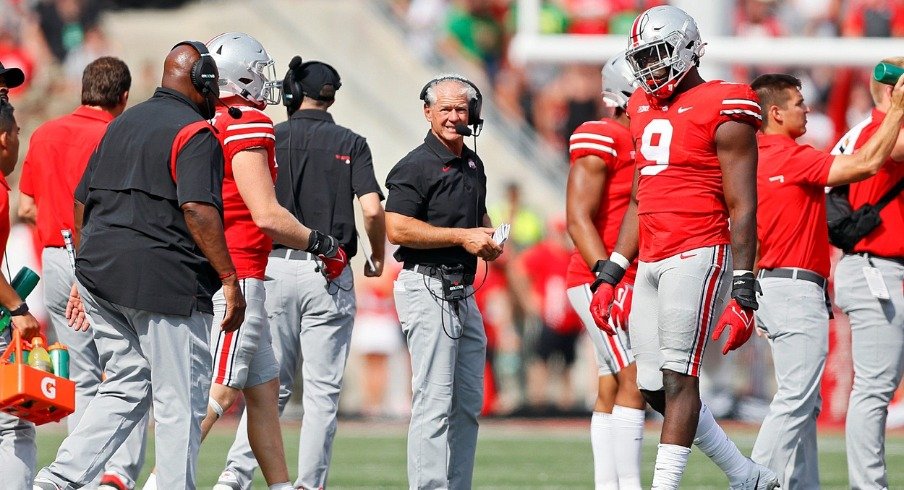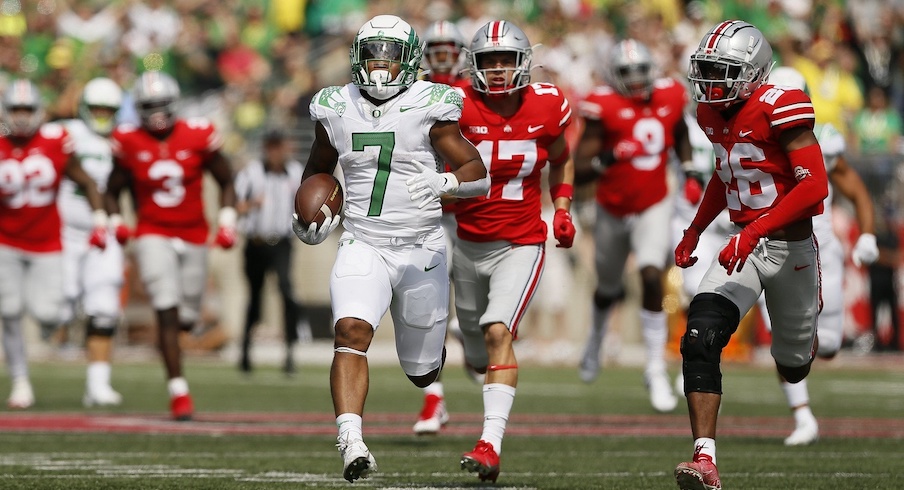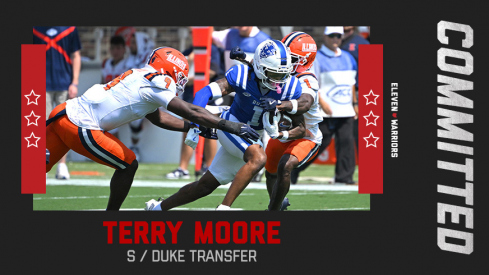Even during obvious struggles from the Ohio State secondary in 2020, the calling card of the past two Buckeye defenses has been its ability to stop the run.
Two games into the 2021 season, and particularly after Saturday’s performance in a 35-28 loss to the Ducks, run defense might just be the Buckeyes’ biggest concern this year, and it has already cost them dearly.
The secondary certainly had lapses of its own, but while starting cornerbacks Denzel Burke and Cameron Brown routinely challenged Oregon wideouts deep down field – tallying four of Ohio State’s nine pass breakups in the process – the Ducks ran all over Ohio State’s defensive line and linebacker corps in Columbus on Saturday. With 269 yards and three scores on the ground in total, Oregon handed Ohio State its first home loss since 2017 and its first regular season defeat since 2018.
“I’m disappointed. That’s how I feel,” Ohio State defensive coordinator Kerry Coombs said after the game. “I hate losing, I hate it with a passion. You don’t come to Ohio State to get beat. You don’t come to Ohio State to get beat in the Shoe. So I’m disappointed.”
Ohio State actually got the stops it needed late, forcing three punts from the Oregon offense in the final half of the fourth quarter, but the damage done early was enough to stop a record-setting day from the Buckeyes’ starting wide receiver trio and a monster C.J. Stroud performance (statistically, at least) from resulting in an Ohio State win.
The Buckeyes have now given up an average of 39.3 points per game in the past three contests dating back to the end of last season, with an average of 511.3 total yards per game in that stretch. On the ground in the first two games of the 2021 season, Ohio State has given up an average of 236 yards.
“I don’t think there’s any question that we have to do things differently going forward,” Coombs said. “Obviously the result today is not acceptable, and so we have to do things differently.”
The Buckeyes held Oregon to just two touchdowns in the first half, which was merciful considering the late second quarter possession in which the Ducks threatened to put up more points before stalling out with a holding penalty. When they did score, it was on ground, and on essentially the same exact play two different times in the second quarter.
Oregon struck first when running back CJ Verdell found nothing but daylight on a 14-yard outside run to the left pylon in the opening minute of the second quarter. The score capped a 10-play, 99-yard drive by the Ducks, who were pinned at their own 1-yard-line on the preceding Ohio State punt.
HAVE A DAY, CJ VERDELL
— PFF College (@PFF_College) September 11, 2021
23 touches
195 yards
3 TDs#CFB pic.twitter.com/Tl49COYyyD
Verdell struck again two possessions later, this time on a forward pitch from Oregon quarterback Anthony Brown that also went 14 yards for a touchdown in a nearly identical manner.
Verdell finished the game with 195 total yards, including 161 rushing, and three touchdowns. His biggest play of all came just three plays into the second half. On 3rd-and-2 at the Oregon 23, Verdell went all but untouched on a handoff up the middle, broke right and churned his way to a 77-yard touchdown with Ohio State cornerback Cam Brown coming up empty-handed on a last-effort tackle attempt. The score put Oregon ahead 21-7.
“I felt like it was a game that we were never really in control of,” Ryan Day said. “I felt like they ran the ball, we didn’t do a very good job of running the football, and because of that, they kind of controlled the game.”
When Ohio State was down 28-21 in the fourth quarter, it was Verdell who converted a crucial third down on the ground, gaining seven yards on third-and-6 to set up a passing touchdown from Brown on the very next play.
However, Verdell was no one-man band in the run game. Brown ran for 65 yards on 10 carries himself, and Travis Dye got in the act as well, running for 43 yards on just eight carries and scoring a five-yard touchdown in the third quarter that kept Oregon ahead by 14 points.
The Dye score appeared eerily similar to Verdell’s two first-half touchdowns.
“The perimeter run play where we didn’t get the crack, that showed up a couple times,” Day said. “So if they hit you with it once, that’s not good, but you want to get it fixed. If they hit you with it twice, then there’s an issue that needs to be fixed. So we need to look at that and figure out what it is.”
Run defense was, without a doubt, a massive issue for Ohio State on Saturday. But Larry Johnson’s defensive line also failed to mount much – or any – pressure on Brown and the Oregon pass attack.
Ohio State did not tally a single sack on the day and finished with just one tackle for loss. Brown finished with a solid showing through the air, completing 17-of-35 passes for 236 yards and two touchdowns.
“They were just getting the ball out of their hands fast,” Ohio State defensive tackle Haskell Garrett said. “Nothing really you can do, you just got to close the pocket. We’re known as the Rushmen, so everybody’s on notice that they have to get the ball out of their hands fast.”
Coombs said the Buckeyes’ defensive scheme has historically been successful and is one that “folks are really comfortable with.” However, he also acknowledged that changes must be made. Ohio State’s next five opponents are not presently ranked in the AP Top 25 Poll, but even with Tulsa and Akron on the docket, it’s clear that major improvements are necessary for the Buckeyes on defense.
“I love the scheme, I love the players and to have the opportunity to be a football coach at Ohio State in this role is a blessing, and I don’t take it lightly,” Coombs said. “And so, we will – I can assure you – we’ll get better.”
- #3 Ohio State 28, #12 Oregon 35
- • Ohio State falls to Oregon in home opener
- • run defense doomed Ohio state as defense struggles persist
- • ohio state had three 100-yard receivers for the first time ever
- • despite the loss, ohio state's goals are still achievable
- • OHIO STATE POSTGAME • Notebook • quotebook
- • PHOTOS • five things • debriefing • three key stats • social reax



